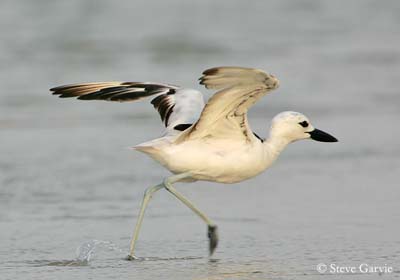
Crab Plover
Dromas ardeola
Charadriiforme Order – Dromadidae Family
BIOMETRICS:
Length: 38-41 cm
Wingspan: 75-78 cm
Weight: 230-330 g
DESCRIPTION:
Crab Plover is a strikingly patterned large wader. When head sunk on shoulders, large head and massive bill (2 to 2,30 inches) give an impression of long-legged gull when seen at some distance.
Oil pollution is an ever present problem, with pollution of mangrove areas, crabs, birds, and hosts of other wildlife. Collection of both eggs and young for human consumption as certainly happened in the early years of this century, until relatively recently (1970), may still pose a serious threat.
Fr: Drome ardéole
All : Reiherläufer
Esp : Dromas
Ital: Droma
Nd: Krabplevier
Russe: Рачья ржанка
Sd: Hägerpipare
Photographs by Steve Garvie
His website: RAINBIRDER Photo galleries
Texte de Nicole Bouglouan
Sources:
HANDBOOK OF THE BIRDS OF THE WORLD Volume 3 by Josep del Hoyo-Andrew Elliott-Jordi Sargatal - Lynx Edicions - ISBN : 8487334202
BIRDS OF AFRICA SOUTH OF THE SAHARA by Ian Sinclair and Peter Ryan - Princeton University Press Princeton and Oxford - ISBN: 0691118159
Wikipedia (Wikipedia, The Free Encyclopedia)
BirdLife International (BirdLife International)

Crab Plover has a massive straight black bill. Its bill is unique among waders, and specialized for eating crabs. It has a disproportional large head, either all white or with at most dark streaking on rear crown and nape.
Plumage is white, except for black on its back and in the primary feathers of the wings, conspicuous in flight. Eyes are large and dark. Tail is greyish, long legs are bluish grey, with partially webbed toes.
Both sexes are similar.
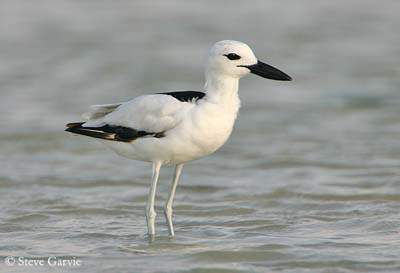
Juvenile lacks distinctive adult pattern, with grey-brown wing coverts, black-brown crown and hind neck, silvery grey mantle and browner tail. It lacks also massive bill and it has shorter legs. They attain adult plumage when they are 15 months old.
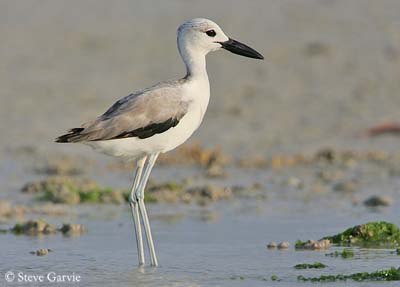
VOICE: SOUNDS BY XENO-CANTO
Crab Plover’s call is a barking, repeated “ka-how, ka-how…” and on breeding grounds, a sharp, whistling “kew-ki-ki” or “ki-twek”. They are noisy birds, calling frequently on their breeding and wintering areas.
HABITAT:
Crab Plover lives on sandy coastlines and islands, intertidal sandy flats and mudflats, estuaries, lagoons, exposed coral reefs, and rocky shorelines. It is found also in sand dunes when breeding.
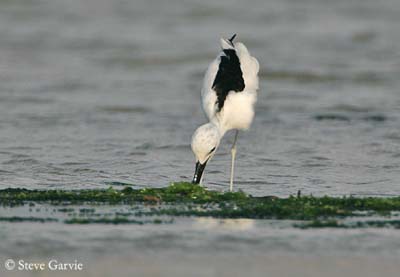
RANGE:
Crab Plover lives on coasts of Indian Ocean. It breeds on shore of N.W. Indian Ocean, Persian Gulf and Red Sea, and Somalia. Non breeders range Kenya, Tanzania and Madagascar, W India and N Sri Lanka.
BEHAVIOUR:
Crab Plover has a characteristic behaviour: it rests on flat tarsi, like sit on the ground.
It feeds with plover-like “run-stop-run-dip-action”. Most often feeds in flocks on mudflats at low tide, or in shallow water. It is most active at dusk and at night. It feeds by picking and probing, and slow stalking. Crab are stabbed which open bill, then crushed and eaten.
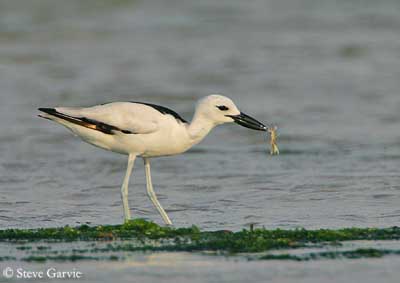
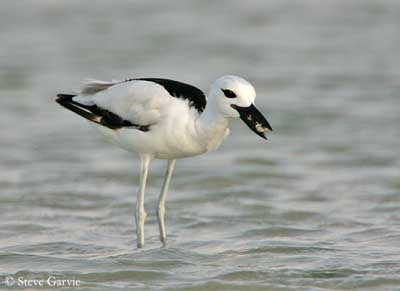
At high tide, Crab Plover use roosts with other shorebirds, or wade out among flamingos.
FLIGHT:
Crab Plover flies strongly, with wing beats rather slow. The legs are projected well beyond the tail in flight.
REPRODUCTION:
Crab Plover’s nest is located in burrow that it digs itself, in sand. It breeds in colonies set close together, as large 1500 pairs, forming honeycombs effect in sandy areas. Nest is unlined chamber at end of burrow 39 to 98 feet long and 19,5 feet deep in sandy substrate.
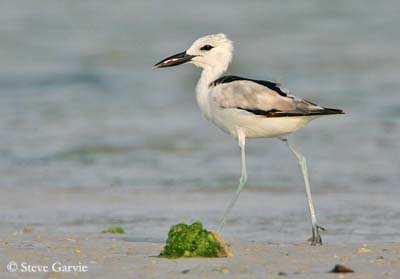
Female lays one white egg, occasionally two, which are large for its body size, at the end of the burrow. Chicks have plain grey down. They are fed by both parents in nest chamber. Chicks are also unique for waders, in being unable to walk and remain in the nest for several days after hatching, having food brought to them. Even once they fledge, they have a long period of parental care afterwards.

DIET:
Crab Plover feeds primarily on crabs, but also crustaceans, small molluscs, marine worms and intertidal invertebrates.
PROTECTION / THREATS / STATUS:
Crab Plover distribution is much localized. Only nine nesting colonies are known in the entire world since 1970.
